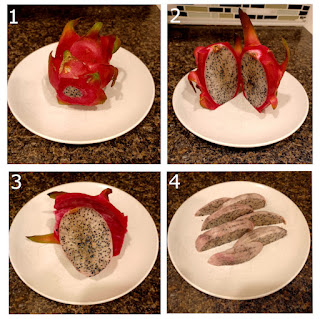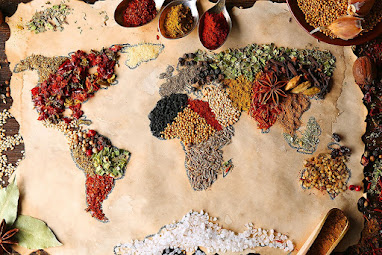The exotic Dragon Fruit
I did some research about Dragon Fruit and I found that this fruit is produced by a cactus, originally the plant is from Mesoamerica. The original name is pitaya and pitahaya, and it cames from the Taino language; it means "scaly fruit". In this century the fruit became very popular in the market, and now there are crops in Asia and other parts of the world with tropical climate; Vietnam is the main producer of dragon fruit around the world. The color of the skin can vary, there are pink, yellow and white; the flesh is always white with black seeds. The cactus need three years to start producing fruits and they can live between twenty and thirty years.

Nonetheless, when I tasted I was really disappointed, despite the looks and the sweetness in the fragrance, the flavor was almost none. A little bit sweet, but nothing more. It was like eat something juicy but tasteless at the same time. I expected something between sweet and sour, like kiwis. It was not the case though.
Despite this first frustration I decide to eat the whole fruit, and I made a fruit salad, with orange, grapes, blueberries and the dragon fruit. Interestingly, the combination with other fruits improves a lot dragon fruit, specially the texture.
Making this experience I learned that I prefer sour and sweet flavors. I like pungent tastes and crunchy textures in food and dishes. I cannot say I really enjoyed this new food, however I would give it another opportunity, maybe in a smoothie or a cheesecake mixed with strawberries and blueberries; I am certain that the texture of dragon fruit can be a plus in a recipe like that. What is more, since it is creamy it can be used in a vegan dessert, and avoid dairy. Maybe it has not to much flavor, but that can be useful in recipes to add smooth textures and volume without adding any flavor.Doing this exercise, trying new foods and analyzing it, it is really useful to explore other aspects related to flavors, textures and new ideas to apply in recipes. Additional, it is a good way to broad our knowledge in our palates. What would be of cooking without experiencing new things? I am convinced that cooking itself is based on experimentation and in play with flavors, textures and different combinations.




Hi Maria
ReplyDeleteI recall that when I was a kid I'd never seen such fruit around - when I googled it I found that this fruit was introduced to Indonesia pretty recently (1977) but not commercially planted until 2000.
one news I read states that Indonesia is competing against Vietnam to become the main importer - apparently geographically Indonesia is a better place to plant the fruit hence it would produce fruit all year
some reccipe ideas is here https://www.idntimes.com/food/dining-guide/naufal-al-rahman-1/dessert-berbahan-buah-naga-yang-segar/7
yes it is in Indonesian but it has pictures that would be self explanatory
Take care
Thank you very much Lucas for the information :) I'm going to give a second opportunity and try those recipes.
Delete